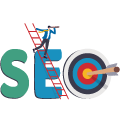There is likely to be a challenge when it comes to increasing the traffic of an online business, but implementing effective e-commerce SEO tactics can bring about a dramatic turnaround. For online retailers, SEO is no doubt advantageous since it provides them with a wider reach, many potential clients and increases their sales. They can promote their growth in e-commerce by enhancing their product site, utilizing proper keywords and offering outstanding ease of use. This article will provide extensive in-depth analysis of useful e-commerce SEO services such as optimizing product descriptions, effective use of backlinks and more. This will help you drive traffic to your online store, stay ahead of competition, make sales and retain customers.
Understanding E-Commerce SEO
E-commerce SEO is the term used to describe the process of enhancing the visibility of your online shop on the SERPs. Essentially, the goal is to ensure that your e-store appears high when anyone looks for the products that you are selling.
In fact, retail e-commerce sales worldwide are estimated to reach $6.33 trillion in 2024, marking an 8.76% year-over-year increase according to Backlinko. As the potential stakes of the e-commerce business increase, optimizing e-commerce stores to enhance its visibility on the SERP becomes paramount.
Unlike general SEO, it focuses on product-specific keywords, improving product pages, and technical factors. A strategic digital marketing approach is essential for effective e-commerce SEO. This consists of improving the descriptions and names and the images on the site to better user experience and the overall ranking.
The same trends can be observed with keyword research that can allow for the targeting of phrases and terms that are used by customers when looking for other products. Knowing these terms allows for a more focused approach to the content that is provided to the customers. With mobile commerce projected to gain more popularity in the near future, there is a strong possibility of reaching a wider audience and increasing conversion levels through mobile optimization. It is by executing effective ecommerce SEO strategies that will enable your online business to acquire more traffic which in turn leads to sales considering the fierce competition in the market.
Benefits of E-Commerce SEO
E-commerce SEO is known to offer various benefits that play a significant role in the success of your online store.
- Increased Organic Traffic: This means businesses that adopt proven solutions for e-commerce SEO will have enhanced visibility in search engines. Moreover, their products will be more organically reachable to target audiences.
- Better User Experience: SEO enhances overall user experience by improving product page optimization, site speed and improving site responsiveness.
- Higher Conversion Rates: Targeting specific product keywords ensures that the traffic you attract can easily convert into loyal customers.
- Cost-Effective Marketing: Unlike paid advertising, e-commerce SEO generates long-term organic traffic, reducing marketing costs over time.
- Improved Brand Visibility: When your brand ranks high on search engines it not just improves your brand’s exposure but helps you reach the right audience too.
- Competitive Advantage: In the right way, these SEO strategies are effective and enable you to rank higher than your competitors. Ultimately, it gives more increased chances of your store being visible for what shoppers go for.
- Enhanced Credibility and Trust: Website that appear in the first page of the search results are considered to be more credible and trustworthy by most customers.
The Importance of E-Commerce SEO in a Growing Market
As e-commerce continues to grow, standing out in a crowded marketplace has become more challenging than ever. Mastering SEO for e-commerce is not just a strategy; it’s a necessity for online retailers who want to increase their visibility and attract potential customers. The numbers speak for themselves: Amazon dominates the landscape, accounting for 40.4% of total retail e-commerce sales in the US, which translates to an impressive $491.65 billion in gross sales in 2024. In comparison, Walmart's retail e-commerce sales reached $83.18 billion that same year.
These figures illustrate the fierce competition that exists, underscoring the importance of implementing effective SEO strategies to drive traffic to your online store. By optimizing your website for search engines, you not only enhance your chances of appearing in search results but also improve user experience and increase conversion rates.
Strategies You Can Use to Drive Traffic
Keyword Research for E-Commerce
One of the foundations of e-commerce SEO is keyword research tailored to e-commerce needs. Here’s how to avoid wasted time and effort in keyword research for e-commerce by employing digital marketing that will bring in the most relevant traffic:
- Identify Target Audience: Define who your customers are, their age, demographic, buying behavior so you can know what keywords to use.
- Use Keyword Tools: Services such as Ahrefs, Google Keyword Planner, or SEMrush can be helpful in conducting searches for a relevant keyword’s search phrases that have high traffic but low competition.
- Long-tail keywords: These keywords target a specific user goal, and since they target specific long-tail keywords that are used, they have less competition hence better chances of conversion.
- Analyze Competitors: Analyze the keywords that your competition is using and look for the gaps which they are not filling.
- Seasonal and Trendy Keywords: Do keyword research in relation to the season or popular trends so that you reach out to time specific traffic.
- Focus on Buyer Intent: Target keywords with commercial or transactional intentions, for instance “buy organic skincare products”, to make sure the people visiting your site are already looking for your product.
- Align with Strategic Digital Marketing Goals: Use keywords that also represent the unique selling propositions of your business to achieve broad marketing goals.
Your e-commerce SEO can enhance the capability of your site in getting the appropriate traffic and boost the conversions.
Optimizing On-Page SEO for E-Commerce Pages
Each page of your site should be SEO-optimized. Specifically, focus on product and category pages of e-commerce sites to ensure that they do not only rank in searches but also encourage users to convert. Here are essential steps to optimize your product and category pages:
- Product Titles and Descriptions: Insert focused primary keywords into the effort of writing product titles and descriptive text. Capture the imaginations of potential customers with well-written descriptions.
- High-Quality Images with Alt Text: Optimize images by using clear file names and descriptive alt text. This boosts accessibility and SEO.
- Unique Meta Tags: Meta descriptions and meta titles should be unique for each page. Adding relevant keywords increases the clicks from the search engines and improves CTR.
- Structured URLs: Ensure the URLs are clean and focused around the keywords related to the content on the page. By doing so, you are helping your users as well the search engines.
- Internal Linking: Use links to other relevant products and categories to facilitate navigation and improve SEO. It also distributes authority around the different sections of your website.
- Customer Reviews: Reviews serve as social proof to generate trust and enhance brand reputation. Product reviews give credibility and also add new content to the product pages.
- Schema Markup: Add schema for products information, prices, stock availability. By doing so it can easily catch the user’s eye and there are high chances of conversion too.
Working with the best search engine optimization agency can ensure these elements are optimized, making your e-commerce site more competitive.
Creating Quality Content to Drive Traffic Organically
An important factor in bringing in organic traffic is content. Relevant, high-quality content informs potential consumers about your products, keeps them interested, and eventually turns them into customers. Some effective content types for e-commerce stores include:
- Product Guides and How-To Articles: Create detailed guides that answer common questions. These build trust and attract relevant traffic.
- Product Comparisons and Reviews: Offer side-by-side comparisons and reviews. Such information comes in handy when visitors need to pick just one product.
- Blogging on Trends and Seasonal Topics: Write about current trends and seasonal themes to keep content fresh and relevant.
- Customer Stories and Testimonials: Share authentic customer experiences to build credibility. Ensure the content us unique as it helps gain visibility via search engines.
- Video Content: Create videos that demonstrate product use. Videos improve engagement on your site and also allows a user to stay longer on the page.
- FAQs: Add a FAQ section to answer popular customer queries. This can capture additional keyword traffic and reduce bounce rates.
- Social Media Promotion: You can gain loyal followers by sharing valuable content on social media and also improve brand visibility.
A strong content strategy is a must if you wish to achieve success in the over competitive world, and a reliable digital marketing agency can help you with the same. Regularly updating high-quality content keeps your audience interested and improves your search engine results.
Optimizing for Mobile and Page Speed
Fast website loading speeds and mobile optimization are essential for the success of e-commerce SEO approaches. Since most online purchases are made on mobile devices, a sluggish, poorly designed website may lead to significant bounce rates and missed revenues. Here’s how to improve both:
- Responsive Design: Make sure you site is responsive and can adapt to various screen sizes effectively. This improves user experience across mobile and desktop.
- Mobile Access Navigation: Easing the navigation process for mobile users. Employ obvious menus, large buttons and search functions that are placed conveniently.
- Optimize Images for Speed: Reduce size of images so that the loading speed is improved. Reduced file sizes will increase the speed of the pages but will not lower quality.
- Minimize Redirects: Do not have too many redirects on your site as these will increase the loading time. This will provide mobile users with a quicker way to get to the content.
- Browser Caching: Make use of caching to save site resources on the gadgets. This helps in decreasing load times for returning clients.
- Limit Third-Party Scripts: Regulate the number of scripts likely to make your site slow, for instance a tracking code. Keep only essential scripts.
- Regular Testing and Monitor: Google PageSpeed Insights can assist in evaluating how your mobile site functions in the real world. Periodic checks allow the speed and usability to be maintained.
These optimizations have a direct bearing on conversions, as well as on ensuring a larger traffic flow to your store.
Leveraging Technical SEO for E-Commerce Success
Technical SEO is very important for boosting the internal authority of your website. To provide both users and search engines with genuinely useful content, online stores should have proper structural organization and countless useful technological features. Basically, technical SEO is the backbone of a successful e-commerce site, as it helps in effective indexing of the page by search engines. Here are key technical SEO tactics:
- XML Sitemap Creation: Create a sitemap to guide search engines through your site’s pages. Thanks to this, search engines can find as well as index the content on the site efficiently.
- Implement SSL Certificate: Protect customer data through HTTPS which is good for customer relations and SEO factors.
- Structured Data Markup: Information such as product, review, and pricing should be given schema markup. These enhance the way the products look on search engine results.
- Canonical Tags: Canonical tags can also be used to get rid of duplicate issues. This in turn helps with consolidation of raking signals of similar web pages.
- Fix Broken Links: Broken links should be fixed immediately since they are damaging user experience, and the impact SEO has.
- Optimize Site Architecture: Sites should be structured in a way where a few clicks can easily take a user to key pages.
- Collaborate with Experts: Hiring the best search engine optimization agency will ensure that your technical SEO is performed properly.
These are a few basic steps that can be implemented to make your website visible and stay ahead of the competition.
Building Backlinks to Your E-Commerce Store
Backlinks still remain a primary organic ranking factor in e-commerce SEO, which assists in the development of the credibility of your website. For an e-commerce site, it is very important to seek backlinks from quality sources that are relevant. Here’s how to gain valuable links:
- Guest Blogging: Create content for industry-specific blogs, including links to your website to attract a focused audience.
- Collaborate with Influencers: Collaborate with influencers who can share links to your products, enhancing credibility and drawing in potential customers.
- Get Listed in Directories: Submit your site to well-known and reputed directories in the same niche. Directories offer credible backlinks that enhance site authority.
- Sponsor Events or Local Charities: Sponsor relevant events or charities for natural backlinks. It helps strengthen the visibility and trust of your brand.
- Create Link-Worthy Content: Publish high-value content like guides, infographics, or case studies. Such content attracts organic backlinks.
- Reach Out to Partners: Request links to your site from business partners or suppliers. It’s a mutually beneficial strategy that builds authority.
- Monitor Competitor Backlinks: Competitor backlinks can be monitored using various tools. Adopt productive sources to remain market competitive.
Increased domain authority through quality backlinks results in better ranks and increased traffic to your store.
Analyzing and Tracking SEO Performance
It is important to monitor SEO metrics as it helps optimize your strategies and maximize return on investment. Here are essential key performance indicators you can track.:
- Organic Traffic: Start by checking the users who visit your website through search engine results. Growth here indicates successful SEO.
- Keyword Rankings: Monitors your store’s ranking for specific keywords. Higher rankings drive more visibility and potential sales.
- Click-Through Rate (CTR): CTR helps to calculate the number of clicks on your site’s listings in search results in percentage. High CTRs indicate the use of captivating titles and meta descriptions.
- Conversion Rate: Measures the amount of traffic who successfully performs a specific action, such as buying something. That is the quality of traffic obtained through SEO.
- Average Session Duration: This applies to how long users stay on your webpage. The longer the time spent, the lower the chances of boredom among visitors.
- Pages per Session: This represents the normal number of pages browsers access in a single visit. Good internal links and interfaces enhance the number of pages browsed in one visit.
- Backlink Quality and Quantity: Assesses the quantity and quality of backlinks to the importance. The more high-quality backlinks there are, the greater the domain authority.
Analyzing these KPIs on a regular basis enables one to determine what strategies are effective and which ones require adjustment to ensure that the SEO technique remains relevant in the future.
SEO for Social Media Integration
Although social platforms don’t directly affect any ranking metrics. But they do help boost traffic to your website and improve the brand visibility, which eventually improves the SEO of your business. The combination of e-commerce SEO and social media marketing assists in furthering the reach of your virtual store and user interaction. Here’s how to make it effective:
- Social Media Profiles Optimization: Include relevant keywords in the description bio and profile. It enhances the search results of the brand when it appears for queries.
- Share SEO-Optimized Content: Post blog articles, product pages, and other optimized content on social channels. These drives traffic back to your site.
- Use Hashtags Strategically: Use hashtags that contain topics related to industry, in order to enhance social networking reach and exposure.
- Connect With Followers: Make comments and answer messages as soon as possible. Engagement increases social signals which may help in SEO.
- Encourage Social Sharing: You can add buttons for social sharing in both products and blog posts. Shares expand their reach and attract new users.
- Create Shareable Visual Content: Infographics, videos, and images attract more social shares. This increases traffic and builds brand awareness.
- Partner with Influencers: Engage influencers who will help advertise your products. The opinion of consumers does change because of influencer endorsements as well as generating organic traffic.
Cross-Link Social Profiles and Website: Join your website with social profiles and the other way around too. It bolsters the power of the brand on various platforms.
With the help of the best digital marketing company, social media and SEO can work together and create a wider scope and stronger online image for the brand.
Latest Technology and Future Trends in E-Commerce SEO
Worldwide trends in e-commerce are incorporating changes in SEO for online stores. The abilities of AI and machine learning are now used to personalize content according to customer behavior. The advanced use of smart speakers leads to the growing importance of optimizing the e-commerce site for voice search, especially long-tail keywords. Image-based searches, making it easier to find products, also increase interest in such industries as fashion and home decor. Augmented reality (AR) enriches the shopping experience, letting customers preview products in their spaces and reducing returns.
As mobile-first indexing plays a role in ranking, having a responsive design and fast loading speeds is essential. Content experience optimization is moving beyond keywords to engaging content that retains users, and sustainable SEO practices attract eco-conscious consumers.
Key Reasons Shoppers Abandon Their Carts and How to Overcome Them
E-commerce companies face a serious problem with cart abandonment, as 47% of online customers say that extra expenses like shipping, taxes, and fees are the main cause of cart abandonment. This figure emphasizes the need to pay attention to an important barrier that can complicate converting any sale for online businesses. It is essential to address what can cause customer clients to leave a website in order to address and improve the shopping experience and conversion rates. Apart from unforeseen expenses, several additional issues may deter a consumer from completing their purchase:
- Requirements for Account Creation: Coming back to the customers, they tend to abandon their shopping carts during the checkout due to the requirement to create an account and many of them wish to only make one transaction. This barrier may induce users to quit if they are searching for an account creation option and this scenario aggravates those who only wish to make a single purchase.
- Delays in Delivery: Customers anticipate timely delivery in the fast-paced world of today. Long shipping times can lead to dissatisfaction, causing potential buyers to abandon their carts in search of quicker alternatives.
- Concerns Over Online Safety: The tendency to leak consumers’ private information due to increasing cybercrime makes them think twice before making a purchase. Such users may refrain from finalizing their trade if such security measures are not clearly stated on the site.
- Long or Difficult Checkout Process: Besides the reluctance to buy, people may feel disappointed because completing complicated processes involving purchases requires a lot of time. Increasing the speed of the number of steps required to complete an e-commerce action is essential for enhancing the customer experience and boosting sales.
By doing this, e-commerce providers will be able to eliminate unnecessary friction in the shopping experience. This should significantly improve business performance by lowering the rate of cart abandonment, increasing overall sales, and instilling customer loyalty. Simple and clear pricing models along with usability will strengthen the confidence of the shoppers in the business and will make them complete their purchases.
Conclusion
In summary, effective implementation of e-commerce SEO strategies is crucial in order to enhance the traffic of your online shop and your conversion. Working with keywords, optimizing the logical structure of the site and the quality of content will be effective in improving the visibility of search engines and attracting the target audience. Additionally, do not forget to regularly assess your SEO results and change your strategies in accordance with current trends. As you do that, not only will user numbers increase as business activity becomes more active, but client retention will be improved as well, contributing to longer business expansion.
For personalized SEO strategies to elevate your e-commerce store, contact us today!



















 Seo Company In Delhi
Seo Company In Delhi  Local Seo
Local Seo  Ecommerce Seo
Ecommerce Seo  Technical Seo
Technical Seo  Video Seo
Video Seo  Seo Company In Noida
Seo Company In Noida  Seo Company In Gurgaon
Seo Company In Gurgaon  Seo Company In Bangalore
Seo Company In Bangalore  Seo Company In Chennai
Seo Company In Chennai  Seo Company In Ahmedabad
Seo Company In Ahmedabad 




